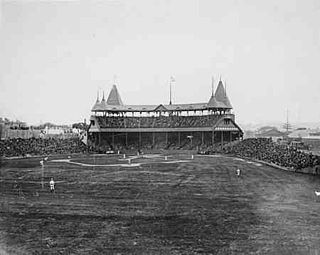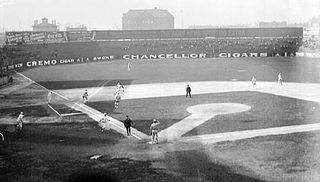Related Research Articles

The Oriole Park at Camden Yards is a ballpark located in Baltimore, Maryland. It is the home field of Major League Baseball's Baltimore Orioles, and the first of the "retro" major league ballparks constructed during the 1990s and early 2000s. It was completed in 1992 to replace Memorial Stadium.
The American Association (AA) was a professional baseball league that existed for 10 seasons from 1882 to 1891. Together with the National League (NL), founded in 1876, the AA participated in an early version of the World Series seven times versus the champion of the NL in an interleague championship playoff tournament. At the end of its run, several AA franchises joined the NL. After 1891, the NL existed alone, with each season's champions being awarded the Temple Cup (1894–1897).

South End Grounds refers to any one of three baseball parks on one site in Boston, Massachusetts. They were home to the franchise that eventually became known as the Boston Braves, first in the National Association and later in the National League, from 1871 to 1914.

South Side Park was the name used for three different baseball parks that formerly stood in Chicago, Illinois, at different times, and whose sites were all just a few blocks away from each other.
Union Grounds was a baseball park located in the Williamsburg section of Brooklyn, New York. The grounds opened in 1862, its inaugural match being played on May 15. It was the first baseball park enclosed entirely by a fence, thereby allowing proprietor William Cammeyer or his tenant to charge admission. This permitted paying customers to watch the games from benches in a stand while non-paying spectators could only watch from embankments outside the grounds.
Newington Park was a baseball grounds in Baltimore, Maryland. It was home to the Lord Baltimore baseball club of the National Association from 1872 to 1874 and to the Baltimore Orioles of the American Association for the 1882 season. There are apparently no surviving photographs of the grounds. Its location was on Pennsylvania Avenue "extended," on the northwest side of West Baltimore.

Ridgewood Park, also known as Wallace's Ridgewood Park or the Wallace Grounds, and frequently confused with Grauer's Ridgewood Park, was a baseball ground in Ridgewood, Queens, New York. Both Wallace's and Grauer's are shown in Belcher Hyde's Map of Newtown in 1915. The baseball field was part of a larger entertainment area bounded Wyckoff Avenue, Covert Street, Halsey Street, and Irving Avenue. The baseball field was southwest of the Long Island Rail Road's Montauk Branch tracks. Eldert Street, although depicted on the map as running through the baseball grounds, was not cut through southwest of the railroad tracks and the road remains interrupted there today. Originally the park was in Queens County, before its incorporation into New York City in 1899. This facilitated Sunday baseball playing, including the charging of admission, beyond the reach of Sabbath enforcers from the then-city of Brooklyn.
Union Base-Ball Grounds was a baseball park located in Chicago. The park was "very visibly downtown", its small block bounded on the west by Michigan Avenue, on the north by Randolph Street, and on the east by railroad tracks and the lake shore, which was then much closer than it is today. The site is now part of Millennium Park.
The Wilmington Quicksteps were an 1884 late-season replacement baseball team in the Union Association. They finished with a 2-16 record and were managed by Joe Simmons. The team played their home games in Union Street Park in Wilmington, Delaware.
The Chicago Browns/Pittsburgh Stogies were a short-lived professional baseball team in the Union Association of 1884. They were to battle the Chicago White Stockings, of the National League, for the Chicago baseball market; however, the Browns lost that battle to the White Stockings. After a Baltimore mattress maker gave the club a degree of financial support, the Browns then tried to entice the White Stockings' Larry Corcoran, one of the 1880s top pitchers, to join the team. However, the club did not succeed in doing so. The Chicago Browns disbanded after a game on August 22, 1884. The club then moved to Pittsburgh and became the Stogies, which disbanded after a game played on September 18, 1884. Many of the club's players then joined the Baltimore Monumentals. Altogether, they won 41 games, lost 50, and tied 2, finishing sixth in the twelve-team league.
The Baltimore Monumentals were an American baseball team in the short-lived Union Association. In their lone season of 1884, they finished fourth in the UA with a 58–47 record.
League Park was a Major League baseball park located in Cincinnati, Ohio, United States. It was the home of the Cincinnati Reds from 1884 through 1901. The ballpark was on an asymmetrical block bounded by Findlay Street (south), Western Avenue, York Street (north) and McLean Avenue (west).

Columbia Park was a baseball field in Altoona, Pennsylvania, which was the home field for the Altoona Mountain Citys of the Union Association (UA) during the league's only season in 1884.

Belair Lot is a former baseball ground located in Baltimore, Maryland. The ground was home to the Baltimore Unions of the Union Association in 1884, with the exception of one game at the Madison Avenue Grounds. The ballpark was also called Union Park or Union Association Grounds.

Oriole Park, often referred to as Terrapin Park, opened in 1914 and closed after a fire on July 3–4, 1944. "Oriole Park" was the name of multiple baseball parks in Baltimore, Maryland, all built within a few blocks of each other.

Oriole Park (V) is the name used by baseball historians to designate the longest-lasting of several former major league and minor league baseball parks in Baltimore, Maryland, each one named Oriole Park.
References
- ↑ James H. Bready, Baseball in Baltimore (JHU Press, 1998: ISBN 0-8018-5833-X), pp. 6-7.
- ↑ Bready, Baseball in Baltimore, p. 9.
- ↑ Retrosheet: Madison Avenue Grounds in Baltimore, MD.
- ↑ Bready, Baseball in Baltimore, p. 36.
- ↑ Retrosheet: Madison Avenue Grounds in Baltimore, MD.
- ↑ 1884 Retrosheet: Log For Belair Lot in Baltimore, MD.
Coordinates: 39°18′35″N76°38′00″W / 39.309804°N 76.633287°W